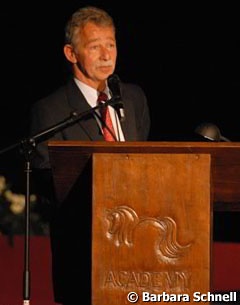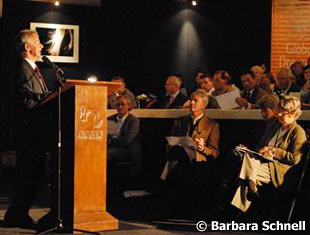
At this year's Equitana, the Xenophon society held a clinic that was the ultimate in open scoring: In front of five thousand spectators, five judges were spread around the arena in their usual positions and judged a couple of riders doing tests
, and later single exercises, from M-dressage to Grand Prix. Each of them had to hold up a sign with the score they had given for each exercise, and if there were discrepancies, the judges whose opinions differed the most had to explain their findings. It was fascinating, and it made you understand the factual difficulties of judging (like judging from different angles). At the same time, there could be no doubt that there is a strong individual component to judging.
At the Global Dressage Forum, two judges who hadn't judged the test in question in Turin and one who had, re-evaluated the findings of their colleagues at the European Championships. A good half dozen movements from the Grand Prix Special were shown on video, each as performed by two different riders. The spectators and panel members were asked to grade the movements, then the actual findings of the judges were discussed. It was a somewhat futile exercise, because in hindsight it is easy to be wiser. Still, it provided to be insightful as well.
Evaluating Isabell Werth's extended trot, moderator Stephen Clarke said he'd have given it a nine even if the opening of the frame left a bit to be desired, since here we had a rider who was willing to ride at full risk. “I think it is the judges' fault”, he said, “that so many riders are afraid to take risks anymore. Besides, I don't give the rider a nine – I take away ten per cent from a ten, and those ten per cent are for the somewhat tight neck.”
 Commenting on the twiching tail of Sunrise during another movement, a half pass, he said that “when resistance is there, you can see it, and this wasn't the case here, so to me, this is not so important.” Another vivid discussion arose during the comparison of the piaffe and consecutive transtion to passage of Balagur and Salinero. Anky got straight eights for the piaffe and 8,9,9,7,8 for the transitions and passage. Alexandra Korelova got four eights and a nine for the piaffe and then 8,8,7,7,8. When asked to comment, Jean Bemelmans said he disagreed because Korelova/Balagur's movement looked completely relaxed and natural, whereas Salinero was clearly tense and didn't show a real passage but only made a transition from piaffe to piaffe moving forward. This, of course, hit the nail on the head and was met with evasion on the side of the judges. Katrina Wüst agreed with the praise of Balagur's natural performance said that she could recognize mechanical movement when she saw it, and it was not the case here. There was a murmur of agreement with Bemelmans' assessment of Salinero in the audience, though, and some even thought that the horse moved like a puppet on strings – not real comment on that part from any of the judges, mechanical movement or no. (Likewise, nobody touched on the fact that it was the Swiss judge who gave Silvia Ikle's highly uneven half pass an eight, where as she got one seven and three sixes from the other judges).
Commenting on the twiching tail of Sunrise during another movement, a half pass, he said that “when resistance is there, you can see it, and this wasn't the case here, so to me, this is not so important.” Another vivid discussion arose during the comparison of the piaffe and consecutive transtion to passage of Balagur and Salinero. Anky got straight eights for the piaffe and 8,9,9,7,8 for the transitions and passage. Alexandra Korelova got four eights and a nine for the piaffe and then 8,8,7,7,8. When asked to comment, Jean Bemelmans said he disagreed because Korelova/Balagur's movement looked completely relaxed and natural, whereas Salinero was clearly tense and didn't show a real passage but only made a transition from piaffe to piaffe moving forward. This, of course, hit the nail on the head and was met with evasion on the side of the judges. Katrina Wüst agreed with the praise of Balagur's natural performance said that she could recognize mechanical movement when she saw it, and it was not the case here. There was a murmur of agreement with Bemelmans' assessment of Salinero in the audience, though, and some even thought that the horse moved like a puppet on strings – not real comment on that part from any of the judges, mechanical movement or no. (Likewise, nobody touched on the fact that it was the Swiss judge who gave Silvia Ikle's highly uneven half pass an eight, where as she got one seven and three sixes from the other judges).
So – it will be interesting to see if the FEI's judging handbook will bring more clarity to this still muddy area – even if, as Stephen Clarke stated, judges are humans, and make mistakes, too.
Back to the 2007 GDF Index